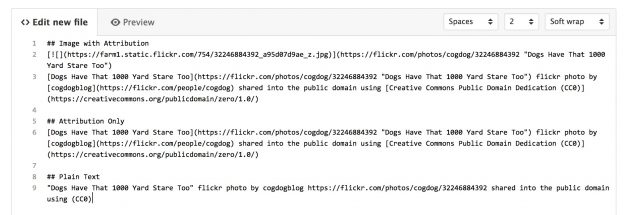Working on the Creative Commons Certification project I keep falling deeper into the nuances of attribution.
Just in the last weeks, I have updated my flickr cc attribution helper to add options use the CC Best Practices (TASL) approach as well to make a cut and paste approach to work for medium.com publishing.
It came out of our team’s work on writing the content that I was reminded by either Paul Stacey or David Wiley that actually CC0 and the CC Public Domain Mark are technically not licenses. They are more an acknowledgement that the owner of a work (CC0) is placing their work into the public domain, e.g. with no copyright restrictions. A Public Domain mark is when a person ascertains that another work is in the public domain, again with no copyright restrictions.
One thing I have noticed, because I more or less built the tool for the way I use it, that something was missing. Previously, you got two options- a full HTML that included the embedded image, and another in plain text, for say, using in a presentation slide, or as I do, in the footer of my posts to give credit for the featured image at the top.
What was missing was an HTML version w/o the image.
Now it’s there.

Now there are three attribution cut and paste options
So for a random photo of a cute dog, my WordPress attribution options give me as cut and paste:
Image and HTML attribution, with WordPress Caption tags

Dogs Have That 1000 Yard Stare Too flickr photo by cogdogblog shared into the public domain using Creative Commons Public Domain Dedication (CC0)
Attribution in just HTML
Dogs Have That 1000 Yard Stare Too flickr photo by cogdogblog shared into the public domain using Creative Commons Public Domain Dedication (CC0)
Attribution in plain text
“Dogs Have That 1000 Yard Stare Too” flickr photo by cogdogblog https://flickr.com/photos/cogdog/32246884392 shared into the public domain using (CC0)
Note also that it says “shared into the public domain” not licensed.
Even looking at this, which is useful to me, I realize that the web page versions require using HTML editors. I guess down the line I could do a rich text version like I did for medium.
Later.
Also, since on the Certification Project we are creating this content in Markdown, the tool that was put into mine (actually contributed by Glen Smith) needed an update, and also a “TASL” version. Changing the license phrasing is easy because it comes from a single Javascript function file.
So now I can get the same as above in cut and paste Markdown.
In code:

The cut and paste markdown code
How it renders in GitHub

How it looks when viewed
I get a lot of questions about “best way to attribute”. If you look around you see an almost infinite number of variations. Even one person (me) is never 100% consistent. There is no “right” way, and thus CC has a set of recommended Best Practices. But there is no rubric or grade sheet.
First of all, any attribution is better than none. To me the most important are the link to the original source and naming the person who made it. If anything, just remember TASL… Title, Author, Source, License. It does not matter what format you use.
They best advice there is– Don’t make it too complicated:
The license tells you to be reasonable:
“You may satisfy the conditions in (1) and (2) above in any reasonable manner based on the medium, means and context in which the Licensed Material is used. For example, it may be reasonable to satisfy some or all of the conditions by retaining a copyright notice, or by providing a URI or hyperlink associated with the Licensed Material, if the copyright notice or webpage includes some or all of the required information.”
There is no one right way; just make sure your attribution is reasonable and suited to the medium you’re working with. That being said, you still have to include attribution requirements somehow, even if it’s just a link to an About page that has that info
It’s the effort that counts.
And here is the way I built this (honestly it was accidental) makes things flexible. Each different kind of attribution on my site is generated from a single html file- the defaults are on my site.
Now you could GitHub fork and pull and all that, but you could also take the tool that is closest to what you desire, download the html, edit it (okay it takes some HTML, javascript chops), and put it on your own server. Just change the URL in the box above to yours, and the bookmark works (I do need to check, there might be local references to my CSS and JS files).
But the point is this thing is rather extensible.
You can attribute it… your way.
Lastly, with all these variations, I do see that it would be more ideal to be able to select different image sizes and attribution styles from a dynamic menu in the window.
Yes, there is always more tinkering to do.
Top / Featured Image: (generated with the new tool so the attribution w/o image has full html) fine tuning flickr photo by mitch98000 shared under a Creative Commons (BY) license



Quick question: Has anything changed recently? I do a free consumer blog for Old Pine Community Center in Philadelphia. They recently moved their website, which took two minutes sometimes to load, to a new site that loads instantly. But I can no longer get the CC attribution helper to work. Nothing seems to happen. Sorry to bother you with this, but I am not sure what else to do. Hope you have time to answer me. And thank you for developing this. It is wonderful. Or was, for me.
I’m not sure I understand what you mean at the helper not working. Describe more or send a link. It just provides you HTML and any web site should be able to display it if you can edit HTML